Christmas Traditions Born on Beacon Hill.
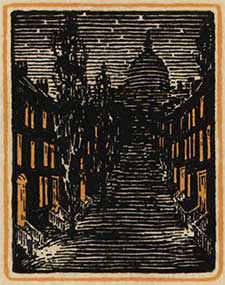
Beacon Hill and Christmas. They seem made for each other. Perhaps more than any other neighborhood in a city steeped in tradition, Beacon Hill evokes nostalgic memories. And those are exactly the kind of thoughts people want as they come together to celebrate the year that’s ending and wish each other well for the one to come. Thus, it’s not surprising that the Hill’s brick sidewalks and gas-lit streets are the birthplace of some of America’s most cherished Christmas traditions.1
Bah, Humbug Beginnings. Cherry-cheeked carolers spread holiday cheer wherever they go. But colonial Bostonians considered such frivolity unpardonable — their dour world frowned on merrymaking, especially outdoors and in public (see When Bah, Humbug Was the Law). Attitudes began to change when immigrants from Germany and other countries with festive Christmas traditions brought their native customs to America. But what finally ended New England’s Bah, Humbug attitude about Christmas and proclaimed Joy to the World was Charles Dickens’ publication of A Christmas Carol in 1843. Dickens and A Christmas Carol were enormously popular in Boston and the book portrayed joyous Christmas celebrations, including people caroling on the streets of London.
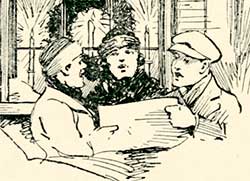
Outdoor Caroling. Perhaps nothing says Joy to the World quite like people actually singing “Joy to the World,” although “Silent Night” and the “Hallelujah Chorus” also work. Christmas Eve caroling on Beacon Hill began with boys from the Church of the Advent singing on neighborhood streets in 1859.4 They continued for a few more years, but seem to have stopped after 1862, perhaps reflecting changes in the national mood as the Civil War entered its third year.
It took a snag at dinner party to bring caroling back in 1906. The host, architect Ralph Adams Cram, found himself unable to concoct his specialty libation. Looking for some other way to entertain her guests, Mrs. Cram suggested that everyone go outside and sing Christmas songs. “With much timidity and deep misgivings,” they went out onto Chestnut Street and sang “Adeste Fideles” beneath one or two neighbors’ windows before running home very frightened.5
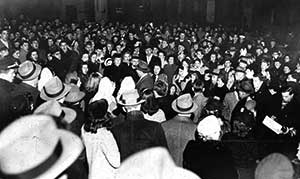
The next year Mrs. Cram and some friends went door to door inviting neighbors to join them caroling. Many people’s biggest concern was that neighbors might hear their singing. Some thought the venture slightly mad, but enough went out that they were able to put on a full selection of popular carols. Pleased with their success, the group founded the Chestnut Street Christmas Association and started a tradition.
As word spread, others joined in, including experienced singers like Dr. Richard Cabot’s group from nearby Massachusetts General Hospital. Soon, carolers began arriving from all parts of the city.
What started as a few timid souls daring to sing outside evolved into a neighborhood-wide celebration. Everyone got involved, even if they didn’t sing themselves. On a particularly cold night in 1927, Dr. Cabot’s frigid carolers were invited up to a newly-married couple’s two-room attic apartment. It was as crowded as a subway car, but nobody seemed to mind as warming beverages were passed hands over heads around the room.7
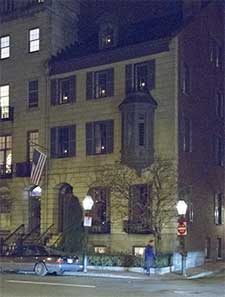
Window Candles. In the dreary depths of the Depression, Christmas Eve 1933 was greeted by a blaze of light shining from rows on rows of candles in each window of every house on Louisburg Square.8 It was a tradition that began just a few blocks away when Alfred Shurtleff put a candle in a third floor window of his parents’ house at 9 West Cedar Street.9, 10 The next year a few neighbors did the same and a few more houses displayed candles every year.
The custom really caught on when the Chestnut Street Christmas Association began sending neighborhood residents a request that everyone display lighted candles in their windows between 6 and 10 p.m. on Christmas Eve so “that the hearts of passersby may be gladdened.”11 The Boston Globe reported that in 1908, nearly every house on Chestnut and Mount Vernon Streets had candles, some only on the first two floors, others in every window on the street side. The view looking up Chestnut Street was described as especially beautiful, with gleaming candle flames on both sides culminating in the illuminated dome of the State House centered at the top.12
The warm, festive atmosphere of candles proved especially welcome in years when rain kept most carolers indoors.13 When carolers were out, they often added to the glow by carrying lanterns. By 1928, the display of candles had grown to the extent that the American Unitarian Building on Beacon Street alone had 420 candles. For Louisburg Square, the newsworthy item that year was the number of houses without candles — one — not the number with them.14 Candle displays were suspended during World War II due to blackout restrictions, but welcomed back in 1945.15
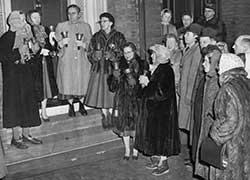
Bell Ringing. Alfred Shurtleff began Beacon Hill’s candle tradition, and one of his in-laws, Margaret Shurcliff, instituted another, handbell ringing. In 1924, she went around Beacon Hill with her children and some of her friends playing songs on handbells she had brought back from England. Soon they formed the Beacon Hill Bell Ringers and a Beacon Hill tradition was established that continues to this day.17
A Hidden Treasure. Christmas Eve on Beacon Hill soon became a city-wide celebration. Streets were closed to traffic and people came from all over to savor the sights and sounds on the streets, admire the priceless antiques in the mansions and glimpse hidden treasures that awaited the knowing. One of those was a tiny cobbler’s shop on Willow Street.
On Christmas Eve, the shop window was illuminated by lighted wicks floating in glasses and the piles of shoes were replaced by a nativity scene. Italian and American flags hung above and a sign on the door thanked customers for enabling the cobbler to send money home to Italy and to assist his son who would soon be finishing medical school and become a doctor.18
The Nation Takes Note. Caroling and candles quickly spread to Back Bay and the Boston suburbs. A national Episcopal publication noted in its Christmas 1920 issue that no one who has been “on Beacon Hill in Boston, on Christmas Eve, singing carols beneath the candle-lighted windows, [will] ever think Christmas quite complete without that part of its brightness.”19
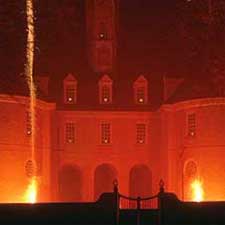
First Lady Eleanor Roosevelt observed the tradition on Beacon Hill when she spent Christmas 1936 in Boston to be with her son, who had just undergone an operation.20 A few years later she commented in her newspaper column that these were some of the Christmas season’s nicest customs and wished that more places followed them.21
Arthur Shurcliff helped take his family’s candle-lighting custom national when the newly opened Colonial Williamsburg was looking to create local holiday traditions. Shurcliff had been the landscape architect for the restoration and suggested they place lighted candles in the windows of public buildings. Today Williamsburg continues the tradition with their holiday Grand Illumination.23
* * * * *
So another year is now ending and the holidays are upon us again. May they bring joy and happiness to you and yours — and may the spirit of the season remind us that what matters can’t be wrapped with a bow, but lives in the heart.
-----
- Information for this article comes from: Abbie Farwell Brown, The Lights of Beacon Hill, The Riverside Press, Cambridge, MA (1922); John R. Shultz, Beacon Hill and the Carol Singers, The Wood, Clarke Press, Boston (1923); Richard Bowland Kimball, Christmas Eve on Beacon Hill, The Atlantic Monthly Press, Boston (1918); Moying Li-Marcus, Beacon Hill: the life & times of a neighborhood, pp. 73-77, Northeastern University Press (2002); Anthony M. Sammarco, Christmas Traditions in Boston, Arcadia Publishing (2017).
- Illustration by Maurice Day from front cover of Richard Bowland Kimball, Christmas Eve on Beacon Hill, op. cit.
- Image from Abbie Farwell Brown, The Lights of Beacon Hill: A Christmas Message, op. cit., p. 15.
- John R. Shultz, Beacon Hill and the Carol Singers, op. cit, pp. 16–17.
- See, Ralph Adams Cram, My Life in Architecture, p. 220, Little, Brown, and Company (1936).
- Image from the Boston Globe, published in on-line special on The Holiday Season in Boston.
- Pietrina Maravigna, “Boston’s Famous Beacon Hill Carolers First Sang 50 Years Ago,” Boston Globe, p. 6 (Dec. 8, 1957).
- “Many Groups Sing Carols in Boston,” New York Times, p. 26 (Dec. 25, 1933).
- Descendants of Mrs. Thomas Dwight say that she put candles in her Beacon Street windows in 1870.
- Elsewhere, the custom can be traced to Irish immigrants. After Catholic priests were ordered to leave Ireland in the seventeenth century, those who remained had to minister in secret. Catholic households placed a candle in a window on Christmas Eve as an invitation to passing priests to say Mass. If questioned by English soldiers, they said the candles were to light the way for Mary and Joseph and the household usually was left alone. See, Catholic Activity: Symbolic Lights and Fires of Christmas, CatholicCulture.org.
- “Chestnut Street’s Christmas Eve,” The Architectural Record, Vol. XXVII, No. 2, p. 202 (Feb. 1910).
- “Sing Hymns in the Streets,” Boston Globe, p. 2 (Dec. 25, 1908).
- “Season’s Joy in Candle Glow,” Boston Globe, p. 16 (Dec. 25, 1910).
- “Thousands Visit Beacon Hill to Hear Christmas Carols,” Boston Globe, p. 1 (1928).
- M.A. De Wolfe Howe, “Discovery and Justice in Louisburg Square,” Boston Globe, p. 1 (Dec. 25, 1945).
- Margaret Shurcliff and friends bell ringing. Photo from the Boston Public Library.
- See Nichols House Museum web site.
- Rose Brooks, “The Christmas Eve Cobbler,” The Christian Register, Vol. 101, No. 2, p. 39 (Jan. 12, 1922).
- The Churchman, p. 8 (Dec. 18, 1920)
- Mrs. Roosevelt describes her 1936 Christmas in Boston in My Day, Dec. 26, 1936, online.
- Comment is in Mrs. Roosevelt’s My Day for Dec, 22, 1939, online.
- Image from article about “Candles in the Windows” on Colonial Williamsburg’s web site.
- Ibid.
This article originally appeared in our free semi-monthly newsletter. To receive future issues, please add your name to the subscription list.

